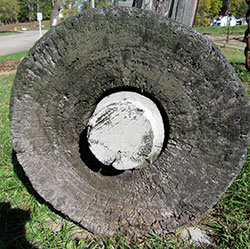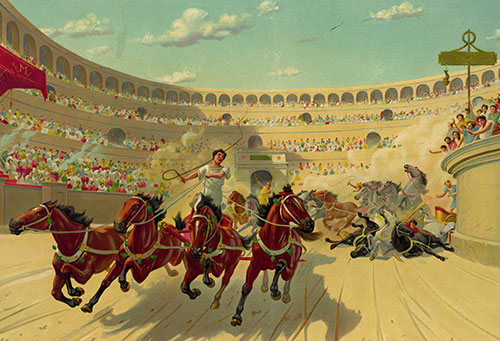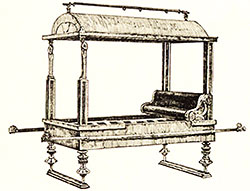Transportation means moving people or things from one place to another. Walking is a form of transportation. So is riding on a horse or a bike, or in a bus, train or car, or even in a plane.
Modern transportation technology lets us travel a hundred miles to go to work, and eat food grown half-way around the world. It's made life much easier for us than it was for our ancestors. But it's caused big problems, too, and given us important choices to make for the future.
Let's go back in time. Pretend that you're a grown-up in an ancient town, ten thousand years ago. Your friends want to move one of these boulders to help build a wall. How would you help them?

It wouldn't have been easy! You might have tried pushing it, or sliding it on an animal skin, or rolling it on logs. Something hadn't been invented yet that would have made moving the boulder much, much easier.
That invention was the wheel. Fire might be the most important discovery of all time, but the wheel could be the most important invention.
The pot in this drawing might look old and beat-up, but it's very famous. It's called the Bronocice pot. Do you see the marks on the left side that look like a cart?

The marks may be the oldest drawing in the world of a cart with wheels.1
The first wheels were used over five thousand years ago in Mesopotamia, where Iraq is today.2 They were big and clumsy, and carved out of solid chunks of wood.

Later, people made wheels with spokes, hubs and axles. They put grease or animal fat between the hubs, so the wheels wouldn't squeak so much. But they still made a lot of noise!
People who lived near water had another way of moving things: they could use boats!
The funny-looking canoe in this photo is the oldest boat ever discovered. It's called the Pesse canoe. It's over 9,000 years old!3

The Pesse canoe is a dug-out boat. People made dug-out boats by digging out the insides of a big log with a sharp stone, or with a deer antler. They could even burn away part of the wood, and scoop out the ashes.
Dug-outs weren't the only way of moving on the water. Some people inflated animal skins and floated on them as if they were balloons. The Egyptians made reed boats, by tying together bundles of papyrus plants.4

Time passed. The Phoenicians built rafts, then fishing boats, then great ships with sails and oars. They traded beautiful fabrics and glass for gold, silver and other raw materials5, and became the greatest traders of the ancient world.6
The Egyptians made wheels with wooden 'tires,' tied to the wheels with strips of animal skin. The Romans used single wheels for wheelbarrows, heavy wheels with studded tires for farm wagons, and light wheels for racing.

They built a giant arena called the Circus Maximus, with space for a quarter of a million people to watch races between chariots.7
The Chinese used crossings and traffic police thousands of years ago. The Romans built fifty thousand miles of roads8, from Brittania to Africa to Syria. Some of the roads are still used today.

In Rome, traffic was so bad that the emperor Caesar made it illegal to move carts during the daytime.9 Then merchants had to drive at night, and the noise of clattering wheels and shouting drivers was so loud that many Romans couldn't sleep.
"Here most sick people die of insomnia," wrote the poet Juvenal. "What rented apartment allows one to sleep? Only if one has a lot of money can one sleep in Rome."10
The Roman streets were terrible for other reasons, too. People just threw their trash out the window11, and let it rot and collect flies in the street. Muggers roamed the dark streets at night, looking for victims.12.
A few Romans were so wealthy that they didn't have to worry about the traffic. They could get others to carry them!
Would you like to take a nap on the bed in this picture?

It's not really a bed. The Romans called it a lectica, or litter. Slaves had to carry lecticas on their shoulders. Rich people could ride in the lecticas with the curtains pulled down, and forget about the noise, bumping and shoving in the streets around them.13
Would you like to carry a rich kid out for recess on a lectica? The slaves probably didn't like it either.
Here's what Juvenal said about litters:
...crowds fall back to allow the wealthy to pass...while on the way they read or write or even take a nap, for the litter and its shut windows bring on sleep. Yet he still arrives first, while we are blocked.14
By the 1500s, sailors were traveling the world in great ships called carracks and galleons, with three or four masts and many sails.15 Stagecoaches traveled regular routes in England, carrying passengers and cargo.16

But in many ways, travel hadn't changed very much. A rider could travel about sixty miles in a day in a stagecoach17, or twenty on horseback.18 A carrack ship might sail eighty miles in a single day.19 Most people spent their lives close to where they were born.
Then, in 1803, a man named Richard Trevithick invented something very important.
Next : Chapter One Quiz
Or : Return to Cover
1 Top 10 Ancient Inventions
2 Judith Herbst, The History of Transportation, (Twenty-First Century Books, 2005), pgs. 7 - 8
3 Facts on the Dugout Canoe
4 Ancient Egyptian Boats
5 Phoenician Enterprising
6 Sicilian People: The Phoenicians
7 Circus Maximus
8 Roman Roads
9 Road Traffic Control
10 Romolo Augusto Staccioli, The Roads of the Romans, (Getty Trust Publications, 2004), pg. 21
11 Staccioli, page 20
12 Ibid
13 Lectica
14 Juvenal: On the City of Rome
15 Ships for Asia
16 Herbst, pg. 11
17 Mile Marker M to B 82
18 What is the Average Distance a Horse Can Travel in a Day?
19 Ships for Asia
 |